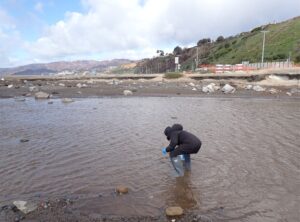Post-fire aquatic monitoring network reaches consensus on thresholds for evaluating chemical exposure risks

A water-quality monitoring network that was formed to track pollution and debris from the Palisades and Eaton fires has reached consensus on a set of thresholds to use for evaluating the human health risks associated with recreational exposure to post-fire chemical contaminants – a key milestone in efforts to bring consistency to how individual monitoring partners use the network’s data to evaluate exposure risks.
The thresholds, which monitoring partners reached consensus on in June, define the concentrations at which recreational exposure to heavy metals and PCBs (polychlorinated biphenyls) in aquatic environments begin to pose an elevated health risk for humans. The thresholds were derived using a U.S. Environmental Protection Agency-developed risk calculator tool.
Prior to reaching consensus on the thresholds, individual monitoring partners were using different sets of thresholds, leading to inconsistent interpretation of the health risks of exposure to these common post-fire contaminants.
The Los Angeles-area Post-Fire Water Quality Monitoring Network, which SCCWRP helped convene in February following two of the most destructive fires in L.A. County history, is tracking how pollution and debris from the Palisades and Eaton fires are spreading through coastal ecosystems and adversely affecting ecological and human health. About 25 agencies are working together to generate high-quality, comparable data on the levels and types of common post-fire contaminants in aquatic systems, as well as general chemistry measurements such as dissolved oxygen and suspended particles.
More news related to: Emerging Contaminants, Regional Monitoring